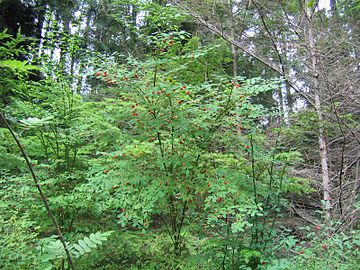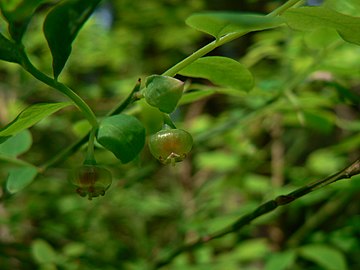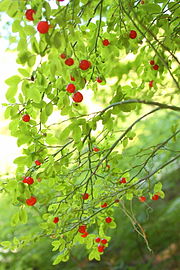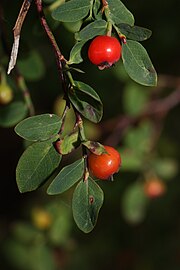Vaccinium parvifolium
| Vaccinium parvifolium | |
|---|---|

| |
| Fruit and leaves in Issaquah, Washington | |
| Scientific classification | |
| Kingdom: | Plantae |
| Clade: | Tracheophytes |
| Clade: | Angiosperms |
| Clade: | Eudicots |
| Clade: | Asterids |
| Order: | Ericales |
| Family: | Ericaceae |
| Genus: | Vaccinium |
| Species: | V. parvifolium
|
| Binomial name | |
| Vaccinium parvifolium | |
Vaccinium parvifolium, the red huckleberry, is a species of Vaccinium native to western North America.
Description
[edit]It is a deciduous shrub growing to 4 metres (13 feet) tall with bright green shoots with an angular cross-section. The leaves are ovate to oblong-elliptic, 9 to 30 millimetres (1⁄4 to 1+1⁄4 inches) long, and 4 to 16 mm (1⁄8 to 5⁄8 in) wide, with an entire margin.[1]
The flowers are yellow-white to pinkish-white with pink, decumbent bell-shaped 4 to 5 mm (3⁄16 to 3⁄16 in) long.[1]
The fruit is an edible red to orange berry 6 to 10 mm (1⁄4 to 3⁄8 in) in diameter.[1] Cytology is 2n = 24.
Distribution and habitat
[edit]It is common in forests from southeastern Alaska and British Columbia south through western Washington and Oregon to central California.
In the Oregon Coast Range, it is the most common Vaccinium.[2] It grows in moist, shaded woodlands.[3]
Ecology
[edit]Birds, bears, and small mammals eat the berries. Deer and some livestock forage the foliage.[4]
Cultivation
[edit]The species is cultivated in the specialty horticulture trade with limited availability as an ornamental plant: for natural landscaping, native plant, and habitat gardens; wildlife gardens; and restoration projects.[5][6] Another cultivated species of similar size and habitats is the evergreen Vaccinium ovatum (evergreen huckleberry).
As a crop plant (along with the other huckleberries of the genus in western North America), it is not currently grown on a large commercial agriculture scale, despite efforts to make this possible.[7] It requires acidic soil (pH of 4.5 to 6) and does not tolerate root disturbance.[8]
Uses
[edit]Indigenous peoples of North America—including the Bear River Band, Karok, and Pomo tribes[9]—found the plant and its fruit very useful.[1] The bright red, acidic berries were used extensively for food throughout the year. Fresh berries were eaten in large quantities, or used for fish bait because of the resemblance to salmon eggs. Berries were also dried for later use. Dried berries were stewed and made into sauces, or mixed with salmon roe and oil to eat at winter feasts.[1]
The bark or leaves of the plant were brewed for a bitter cold remedy, made as tea or smoked.[1] The branches were used as brooms, and the twigs were used to fasten western skunk cabbage leaves into berry baskets.
Huckleberries can be eaten fresh or dried or prepared as a tea or jelly.[1][8]
References
[edit]- ^ a b c d e f g Holm FG (May 2004). "The Natural History of Vaccinium parvifolium Smith, the Red Huckleberry". The Evergreen State College, Olympia, Washington. Retrieved November 25, 2014.
- ^ Pojar, Jim; MacKinnon, Andy (2004). Plants Of The Pacific Northwest Coast: Washington, Oregon, British Columbia & Alaska. Auburn, WA: Lone Pine Publishing. p. 105. ISBN 978-1-55105-530-5.
- ^ "Vaccinium parvifolium". ucjeps.berkeley.edu. Retrieved 2022-09-16.
- ^ Whitney, Stephen (1985). Western Forests (The Audubon Society Nature Guides). New York: Knopf. p. 419. ISBN 0-394-73127-1.
- ^ "Vaccinium parvifolium". California Native Plant Link Exchange. Retrieved November 25, 2014.
- ^ "Vaccinium parvifolium". Jepson Horticultural Database. Retrieved November 25, 2014.
- ^ "Information on Huckleberry Plants". Northwest Berry & Grape Information Network. Archived from the original on July 20, 2013. Retrieved November 25, 2014.
- ^ a b "Vaccinium parvifolium". Plants for a Future. Retrieved November 25, 2014.
- ^ Nyerges, Christopher (2017). Foraging Washington: Finding, Identifying, and Preparing Edible Wild Foods. Guilford, CT: Falcon Guides. ISBN 978-1-4930-2534-3. OCLC 965922681.
External links
[edit]- "Vaccinium parvifolium". Germplasm Resources Information Network. Agricultural Research Service, United States Department of Agriculture.
- Jepson Flora Project: Vaccinium parvifolium
- Native American Ethnobotany: Vaccinium parvifolium
- Plants of British Columbia: Vaccinium parvifolium
- USDA: Vaccinium parvifolium
- Vaccinium
- Berries
- Flora of the West Coast of the United States
- Flora of Alaska
- Flora of British Columbia
- Flora of Oregon
- Flora of Washington (state)
- Flora of California
- Flora of the Cascade Range
- Flora of the Klamath Mountains
- Flora of the Sierra Nevada (United States)
- Plants used in traditional Native American medicine
- Plants used in Native American cuisine
- Garden plants of North America
- Bird food plants





